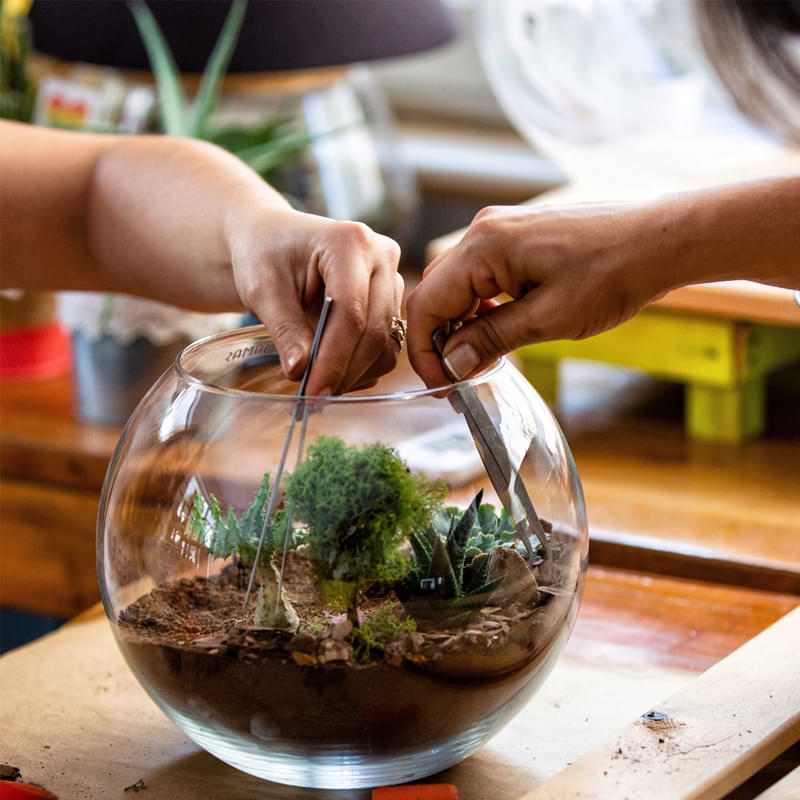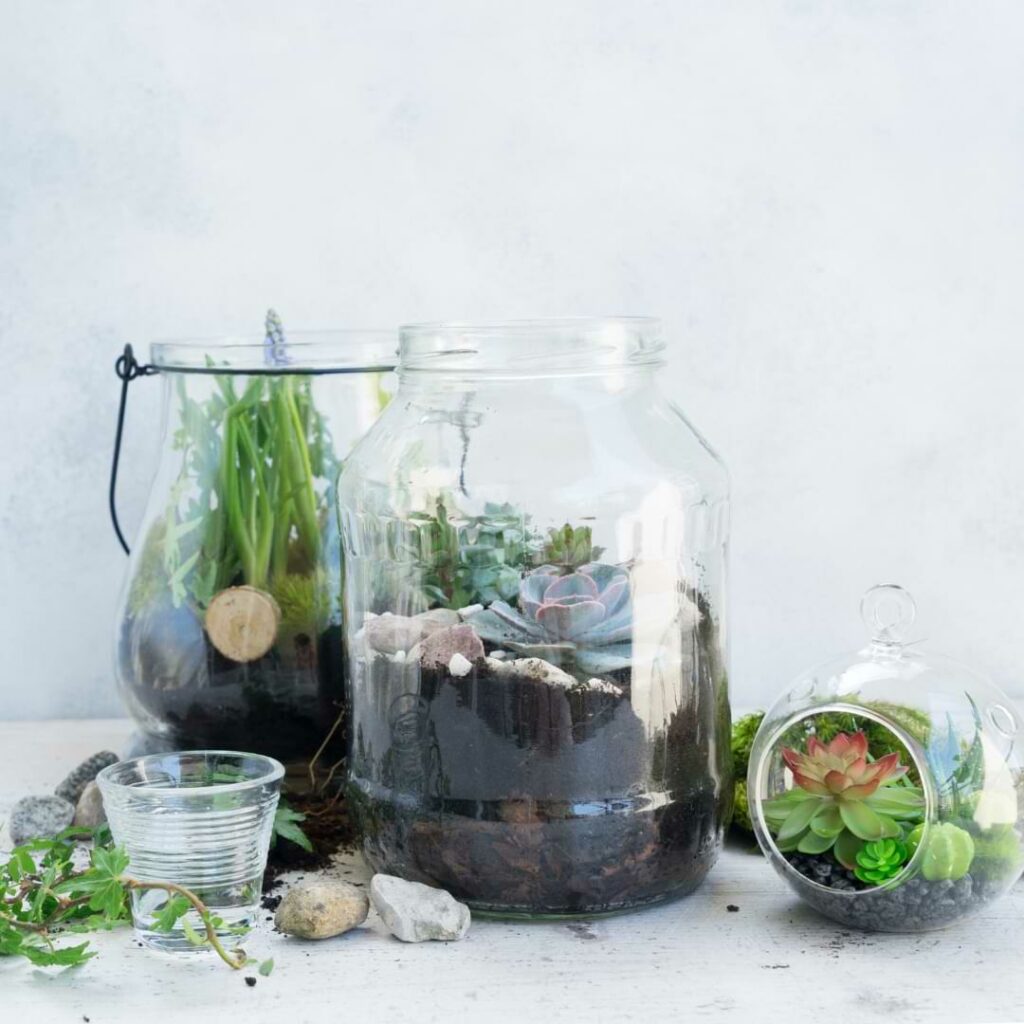Looking for a way to add a splash of color to your home décor? Or maybe you’re in the market for a new pet-friendly plant. Either way, an African violet is a great option, and setting it up in a beautiful terrarium will make it even more eye-catching! Not only are they beautiful, but they’re also relatively easy to care for. So let’s dig in to how to set up your African violet terrarium and how to care for it afterwards.
Growing African Violets in a Terrarium or Vivarium
Terrariums and Vivariums are enclosed environments perfect for growing African violets, as they provide the humidity and warmth that the plants need to thrive. Many people love the look of a beautiful plant inside of a glass structure of some sort, and who can blame them? They are a stunning option for any plant lover.
Types of Terrariums for African Violets
There are many types of terrariums that you can use to create the perfect environment for your plants. There are a ton of options available as plant terrarium popularity has soared, including closed terrariums, open terrariums, large or small terrariums, glass or plastic terrariums, and more. Here is a quick look at some of the most popular types of terrariums for African violets.
Closed Terrarium
A closed terrarium is a great way to grow African violets and other delicate plants. By enclosing the environment, you can create a space that is warm and humid–just the way these plants like it. Plus, a terrarium makes a beautiful addition to your home décor.


Open Terrarium
An open terrarium can provide you with just as much beauty as a closed terrarium, but it will require more care and attention. An open terrarium will dry out, requiring you to water it like a normal house plant. Pests could also get to your plant in an open terrarium, so keep that in mind as well.
Mini African Violet Terrarium
For a smaller terrarium that still makes a statement, consider making a mini African violet terrarium! Miniature African violets make beautiful and long-lasting houseplants, and they look stunning inside a terrarium. You can even add it as a smaller plant in a multi-plant terrarium! Just make sure all plants in the terrarium are compatible with humidity and light requirements.
Keep reading for a step-by-step guide to help you set up your terrarium!
African Violet Vivariums
Vivariums are enclosed glass or plastic containers that create a mini-environment for your plants. They’re ideal for African violets because they provide the high humidity that these plants need to thrive.
The difference between a terrarium and a vivarium are small, but they are still there. Technically speaking, terrariums are more suitable for growing plants, but a vivarium can work just as well for your African violet. Vivariums sometimes have other equipment that help maintain ideal conditions inside the container, whereas a terrarium is essentially its own mini ecosystem that can sometimes even take care of itself.
Caring for African Violets in Terrariums and Vivarium
Terrariums and vivariums can provide the perfect environment for African violets, as they mimic the plant’s natural habitat. The key to success is to create a microclimate that is warm, humid, and has bright indirect light. Some people say that caring for an African violet in a terrarium or a vivarium is easier than caring for one in a regular pot!
African Violet Soil for Terrariums
If you’re growing African violets (Saintpaulia) in a terrarium, you need to use a special type of potting mix. This is because the roots of the plant are very sensitive and can be easily damaged. A good African violet potting mix should be light and airy, well-draining, and high in organic matter. It should also be low in fertilizer to prevent burning the delicate roots.
You can buy a pre-made African violet potting mix that is specifically designed to have everything your African violet needs. Or, you can make your own mix by combining equal parts peat moss, perlite, and vermiculite. If you want to add some extra nutrition to the mix for your plants, you can mix in a small amount of bone meal or blood meal. Just be sure to avoid using too much fertilizer, as it can burn the roots.
When potting African violets for a terrarium, be sure the soil is clean. Don’t use soil that has been sitting outside or soil that has been exposed to pests, bacteria, or disease. Problems like those can kill your plant even faster inside a terrarium.
Humidity
African violets (Saintpaulia) originate from Africa, where they grow in the eastern rain forests at altitudes of 3,000 to 6,000 feet. The natural habitats of these violets are very humid, averaging 80% relative humidity or higher.
When growing African violets in captivity, it is important to recreate their natural habitat as closely as possible. This means providing them with a high level of humidity, and growing them in an enclosed terrarium can give them the perfect level of humidity consistently. Therefore, closed terrariums are sometimes easier to keep plants alive in.
For both closed and open terrariums, it’s important to monitor humidity levels with a humidity meter, and adjust humidity levels accordingly. Keep in mind, for open terrariums, you may need to increase the humidity around your plant more often. There are a few ways to do this:
– Use a humidifier: This is the easiest way to add extra humidity to your home and is especially useful in the winter when indoor air is typically very dry.
– Group plants together: Another way to increase humidity around your plants is to group them together inside the terrarium, just be sure not to overcrowd your plants.
– Mist plants regularly: Misting your plants with water is another great way to raise the humidity levels around them. Just be sure not to mist the leaves themselves as this can make your plant more prone to disease and fungus.
Watering Requirements & Drainage
Watering inside a terrarium should be rather minimal. In an enclosed terrarium, you should hardly need to water at all, and in an open terrarium, it simply depends on the surrounding environment. The key is to keep the soil moist but not soggy. Allow the top of the soil to dry out slightly in between watering. Over-watering can lead to root rot, so be sure to water only when needed, especially for your enclosed terrarium.
Drainage works a bit differently for terrariums, as the water is typically recycled. So follow the steps below when setting up your terrarium to ensure proper drainage for your plant.
Homemade African Violet Terrarium Set-Up Guide
Terrariums and vivariums are so easy to set up, it’s something nearly anyone can do, and kids can even help with it! You can essentially add whatever you would like to your terrarium, as long as it isn’t going to negatively affect your African violet or any other plant you want to put in it.
Here’s what you need to know to set one up for your African violet:
- Choose a suitable container. A glass jar or fishbowl works well for a small terrarium, while a larger aquarium can accommodate a more ambitious design. Terrariums are becoming more and more popular, so you should be able to find a variety of choices at your local craft store.
- Create a drainage layer. Place rocks, charcoal, or pebbles at the bottom of your container to provide drainage and prevent root rot. Charcoal is highly suggested, because it helps keep bacteria at bay and would help the overall health of the environment inside the terrarium. Ideally, you could put a layer of pebbles, then charcoal, and then top with soil in the next step.
- Add soil. African violets prefer a loose, well-draining potting mix. Don’t add too much at first, you’ll be building up with soil after you place your plant inside the terrarium.
- Place your African violet in the terrarium. For multiple plants, make sure the container is large enough, and then arrange the plants so that taller ones are in the back and shorter ones are in the front. Be sure to leave enough room between each plant for air circulation.
- Secure your plants with more soil around their roots as needed.
- Water plants lightly. Use a spray bottle to mist the soil (not the leaves) with distilled water until it is evenly moistened but not soggy. Too much water will cause problems with fungal diseases, so err on the side of too little rather than too much. Try not to use tap water, especially for an enclosed terrarium, as there might be things in the water that would just multiply inside the micro-environment you are creating.
- Close up your container, place it where it’s going to live, and enjoy!
African Violet Terrarium and Vivarium Final Thoughts
As you can see, setting up an African Violet Terrarium or Vivarium is easy, and it doesn’t have to be expensive. The most important part is providing the right environment and care for your plants.
With a bit of effort, you can have a beautiful and healthy African Violet display that will last for years, so go grab your terrarium and start planting!Looking for more houseplant info? You can find more information on African violets when checking out our African Violet Resource Center page or joining our Facebook group!





